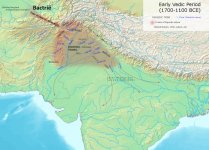The same way the rest of their language was replaced, I would imagine. It's not like
all Indians lost the native terms, just (eventually) the majority.
As for Proto-Indo-European naval knowledge, we know they were familiar with boats, rowing, seas, waves, etc.
I believe the migration was largely a done thing by 3,000 years ago. Dating the Rigveda to a few centuries before that poses no problem, especially as portions of it describe the conflict between incoming Aryans and the natives.
Indo-Europeans weren't strangers to naval battles at that point in history, at least to the west. I don't see why it couldn't be so in the east, especially with the natives having such an advanced naval tradition to build on/co-opt.
As for elephants, what's meaningless on the steppe becomes quite relevant when the people you're fighting have tamed elephants, what?



